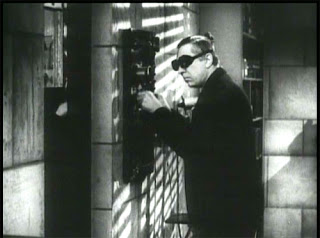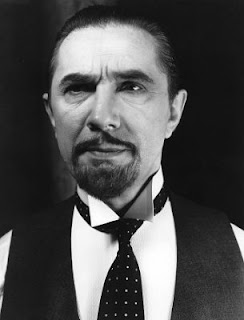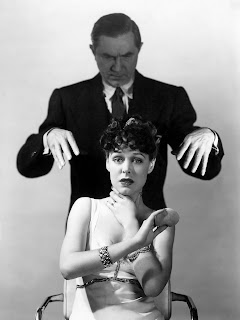Scared to Death (1947)Starring: George Zucco, Bela Lugosi, Nat Pendleton, Molly Lamont and Angelo
Director: William Christy Cabanne
Rating: Four of Ten Stars
In "Scared to Death", Laura Van Ee (Molly Lamont) relates the final few hours of her life where her sordid past caught up with her, and she was.. well, scared to death. She is on a slab in the morgue as she relates a tale of a loveless, yet co-dependent to an extreme degree, marriage to an ethics-challeged psychiatrist (Zucco); a discredited doctor and hypnotist, Leonid (Lugosi), and his ill-tempered long-time midget companion; a bumbling bodyguard (Pendleton) who wants nothing more than to have a murder occur, so he can solve it and get back in good standing with the police force; a super-annoying reporter and his airhead girlfriend; the skittish maid; and a mysterious blue-gree face that keeps hovering outside the windows. The presense of these strange and whacky characters all add up to Laura being dead by the movie's end... and being in the morgue where we started.
No... I'm not giving the ending away, because the title gives it away. The fact that the opening scene has Laura dead in teh morgue gives it away. So, suspense over whether she's going to live or die is never an issue in the film. How she is going is going to die isn;'t an issue either. The mystery as to "why" does come up every so often during the film, but it's not really something that viewers are all that concerned about. The insanity of the proceedings is more what we're focused on.

"Scared to Death" is either a really bad horror movie, or an incredibly quirky comedy (although not necessarily a good one). This short B-movie (which is one of Bela Lugosi's few color appearances, by the way) left me so confused about what the filmmakers had been hoping to accomplish that I did some searching online in hopes of finding some reviewer who could give me a little context.
Well, no one seems to have more of a clue about the film than I do, so I'm going with my opinion that "Scared to Death" was intended as a comedy--a horror movie spoof, actually--but it somehow went awry. (In fact, I think most of the reviewers I came across with my quick Google search have looked at "Scared to Death" in the wrong way. I don't think it was intended as a horror film, at least not when principle shooting was going on.)
Every actor, except the woman who is being scared to death, delivers their parts and their lines in a comedic fashion. (If you take a look at comedies from the 30s and 40s, you'll know what I mean by that.) I've seen Nat Pendleton as the comic relief screwball character in two or three other films (most notably the very excellent "Trapped by Television" ), but his antics pale next to those of Lugosi and his look-alike midget buddy, and several other minor characters that appear. Further, Lugosi's delivery as he plays Dr. Leonid is very similar to how he played his parts in the clear-cut comedies "The Gorilla" and "Abott and Costello Meet Frankenstein". (In fact, critics often praise Lugosi's comedic timing in "Meet Frankenstein", but I think his talent for comedy is even more clear in "Scared to Death" during his scenes with the cranky midget.
If considered as a pseudo-screwball comedy horror spoof, "Scared to Death" is not all that bad--if very, very strange. The film never manages to build the frenetic pace it would need to fully work, because the unfolding chaos is constantly interrupted by cut-aways to Laura at the morgue so she can deliver obvious and dull commentary on what we've just seen, or are about to see.
If viewed as a horror film, "Scared to the Death" is a complete and total disaster--unscary and utterly insipid--that is made worse by the lame cut-aways to the morgue and the tension-dispelling framing device that establishes Laura is already dead.
However you think of the film, the morgue scenes don't fit. In fact, they feel out of place and tacked on. They lead me to suspect that they were added by studio executives who were trying to reshape a bizarre comedy into a horror movie, because, according to two different websites, "Scared to Death" was completed several years before its 1947 release date.
If I'm right in my speculation--and it is just speculation, as I haven't done all that much research--I can't help but wonder what "Scared to Death" might have looked like if it had remained the comedy is was intended to be.
I'm giving "Scared to Death" a four-star rating, because I'm treating it like a comedy. If it wasn't for the morgue cut-aways, it would be a Five or Six film. (If I were to treat it like a horror film, we'd be talking One or Two Stars, and those would be awarded unintentional comedy.)






